The Cave Divers Association of Australia (CDAA) - Linking Landowners to End-Users
Abstract
The Cave Diver’s Association of Australia (CDAA) formed in 1973 in response to a number of high-profile cave diving deaths and today has nearly 700 members and a safety record that is second to none. Land owners and managers entrust CDAA with ensuring the safety of divers through training, access conditions and equipment requirements. Often land owners impose site-specific caveats and entrust the CDAA to enforce those access rule, which they do through a range of measures including the punishment of offences with suspensions, fines and/or, in the extreme, expulsion from the Association.
Benefits to landowners include that they have a single point of contact (a site manager), day-to-day enquires regarding access are dealt with on their behalf, and over time the CDAA often install and maintain infrastructure such as steps, ladders and benches. Benefits to members include that high-quality training is available in Australia, access is negotiated for and arranged on their behalf, a network is available to locate appropriately experienced guides, and there are many sites now with infrastructure such as a gantry for lowering gear and kitting-up benches.
Background
Jacques Cousteau and his team made the world’s first open-circuit cave dives at the Fontaine de Vaucluse near Avignon in 1946.1 Soon after, the first compressed-air dives in an Australian cave were made at Jenolan Cave’s Imperial Sumps in 1952. Piccaninnie Ponds was explored in 1961 and the now famous Shaft followed in 1964, so named for the spectacular shaft of light that penetrates the dark like a giant laser.2 By then, the winds of change were sweeping our world. Television brought adventurous pursuits into people’s homes and a wealthier, more mobile generation of Australians took to scuba diving. The sport blossomed. The water in many caves is reliably clearer than a diver is likely to ever find in the sea, and the prospect of being lowered down to the water is, in itself, attractive to some adventurous types so it was only a matter of time before cave-diving gained popularity. The first cave-diving fatality in Australia occurred in 1969, followed in short order by a further ten deaths in flooded caves near Mount Gambier by mid-1973.3 The worst of these took four lives from a single dive group and almost a year passed before the last body was located. There were calls to ban diving in caves, many land-managers did close off access to diving, one cave was even re-named “Death Cave” and a steel lockable lid was put over it, with little regard for the resident flora and fauna. Something needed to be done so the Government of the day agreed to consider voluntary regulation of the sport before treading down the legislative path.

Photograph 1: A diver enters the cavernous Piccaninnie Ponds
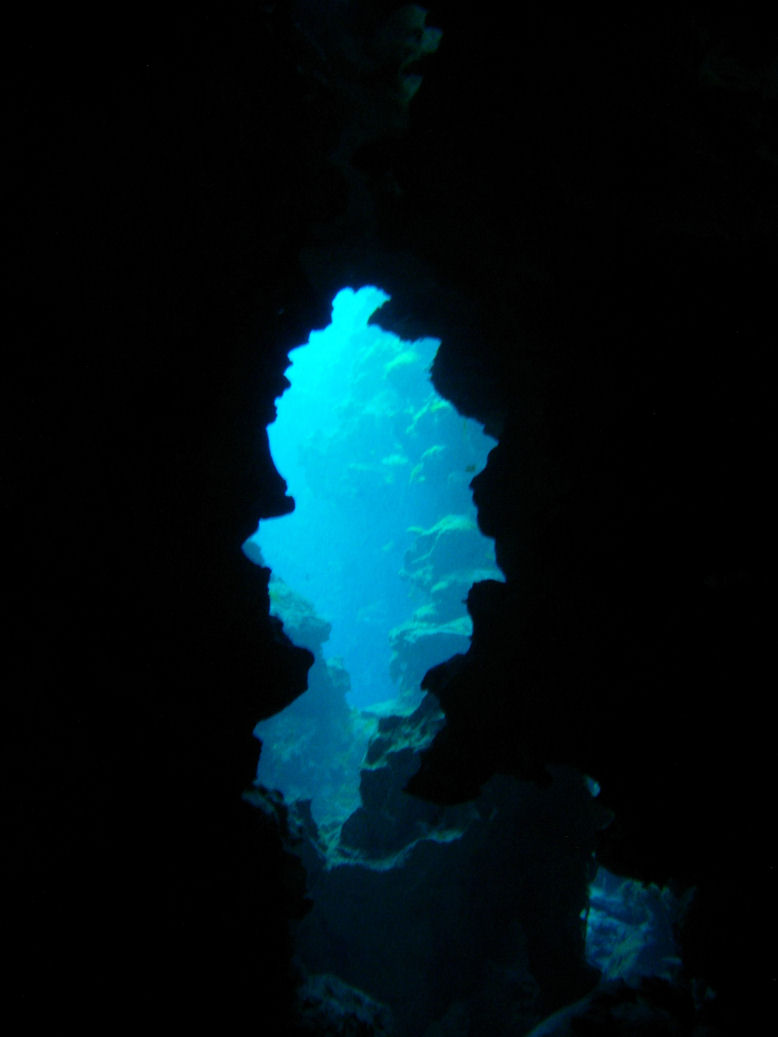
Photograph 2: The view from inside Piccaninnie Ponds

Photograph 3: A diver exits the ponds after another great dive

Photograph 4: The manhole-like entrance to the shaft

Photograph 5: A diver’s view whilst being lowered to the water
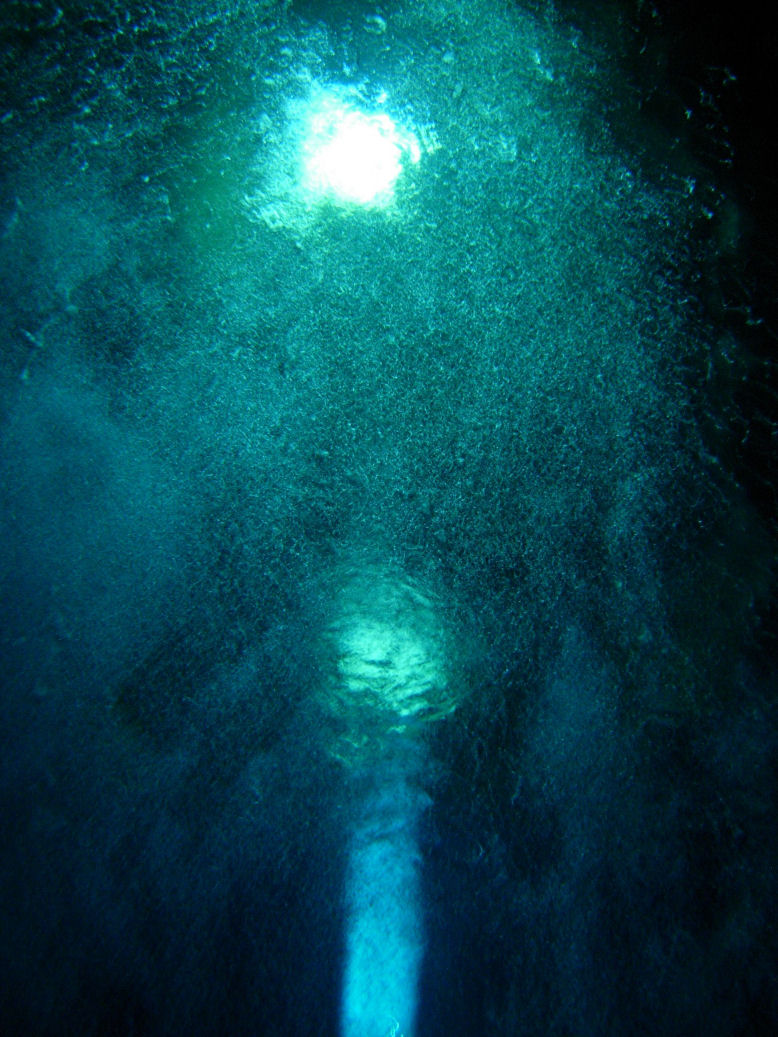
Photograph 6: The famous laser-like shaft of light cuts through the dark
The Cave Divers Association of Australia (CDAA) was conceived on 29th September 1973 in the Allendale East Public Hall, when a group of divers met to elect the first committee, draw-up a constitution and agree a set of standards for cave diving in the Mount Gambier region.4 A year later the constitution was ratified and, having explored cave diver training and procedures in the USA and the UK, the group presented their recommendations to a meeting of 71 divers. A new system of categorizing caves and testing divers was described, printed safety information distributed and the latest cave diving equipment shown around.
Dive clubs were invited to nominate club testers with prior experience in cave diving and the first examinations of club testers were carried out as soon as October 1973, and again in February 1974. Though some experienced cave divers may have objected to being tested in order to continue the sport they had experience in already, the CDAA gained widespread acceptance by Government, dive clubs and land owners, and some of the popular caves re-opened to cave-diving.
Mount Gambier lies near the South Australia/Victoria border and the CDAA was initially split between these states in two separate groups. Category 1 and 2 caverns and sinkholes afforded suitably tested divers access to a dark zone, frequently up to 40m deep, but full cave diving had been on hold until the first Category 3 test held at Piccaninnie Ponds in May 1975. Divers from Victoria were tested by the South Australian Group, and South Australian divers by Victorian testers, a practice that continued for some years.
With the continued growth of recreational diving, and since the arrival in Australia in 1972 of the Professional Association of Diving Instructors (PADI), the diving ‘industry’ grew and Australia’s own training agency, the Federation of Australian Underwater Instructors (FAUI) grew with it. Demand for diver testing outgrew the limited availability of testing weekends so, after robust debate, FAUI instructors who were also rated Category 3 divers were accepted to train and test prospective CDAA members.
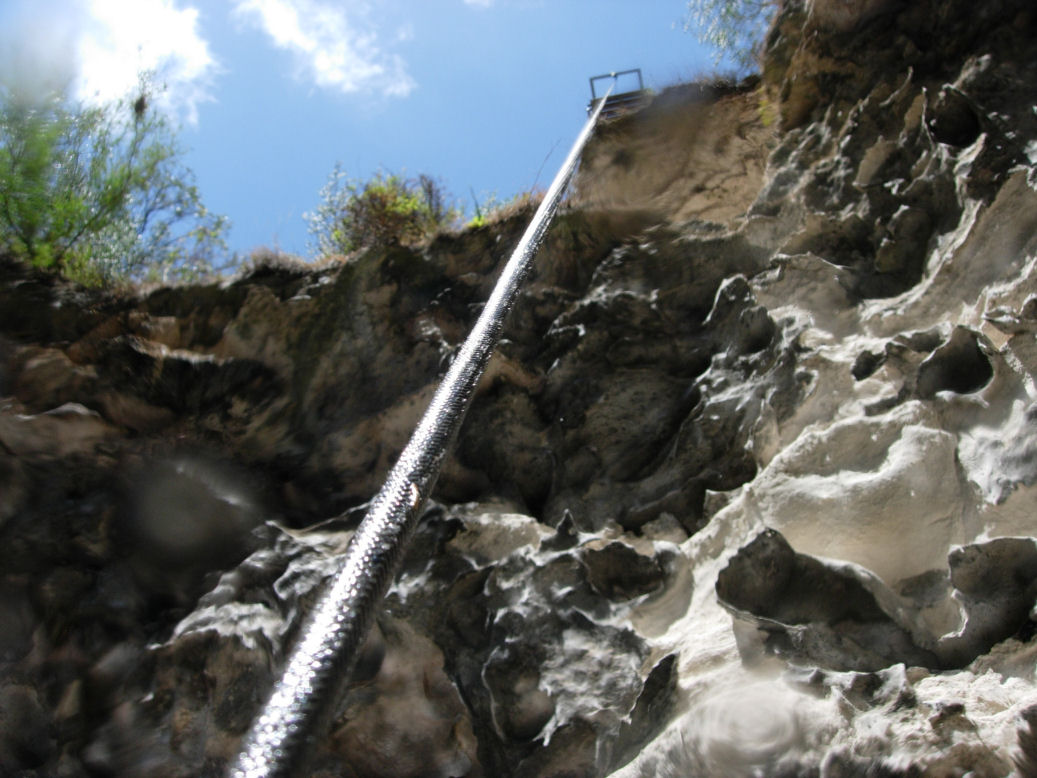
Photograph 7: The drop to the water at Hell’s Hole is not for the faint hearted
By 1978 the CDAA was continuing to forge strong alliances with land managers and Government, establishing itself as the peak body in Australia for cave diving. The Woods and Forest Department of South Australia granted legal access to qualified CDAA divers to visit the caves known as Pines and Hell’s Hole. For the first time since 1973 divers could obtain permits to dive these caves, and this permit system has worked successfully over the 31 years since. Even today, any current member of the CDAA who wants to dive either cave simply telephones the staff at the Forestry SA office in Mount Gambier, requests a permit, and it is available to be collected from a collection box outside soon after. The permit is a legal document and access is granted provided certain conditions are met, for example to dive Hell’s Hole the group needs to be no smaller than four divers, one of whom must have dived there at least once before. If a group of divers were to surface from a dive and find the ranger ready to check if permit conditions are being met, (and it is quite common to find the rangers just so engaged), then breaking an access condition would certainly result in some form of penalty, ranging from an ‘in-house’ punishment for a minor breach (like suspension from the CDAA), right up to prosecution, and divers have actually been prosecuted by the Government for breaching access conditions. Put simply, there will always be members in any community who test their boundaries, but breaking the rules threatens continued access for divers and land managers know the CDAA vigorously investigate every reported breach. Thankfully, by far the majority of the CDAA membership not only follow the rules but are somewhat also self-policing by their intolerance of inappropriate attitudes.
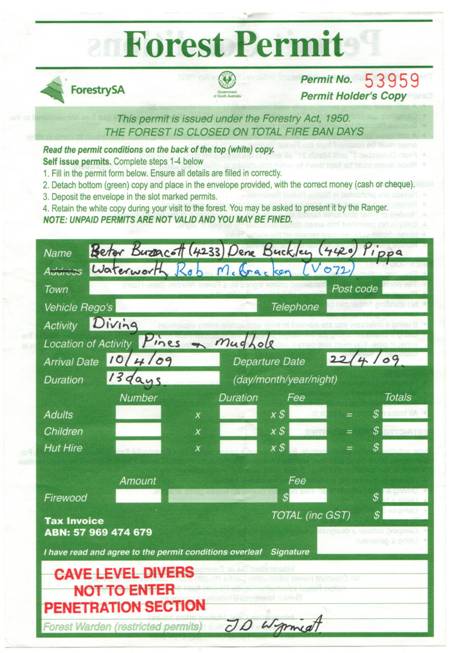
Photograph 8: Firstly, a diver applies for a permit
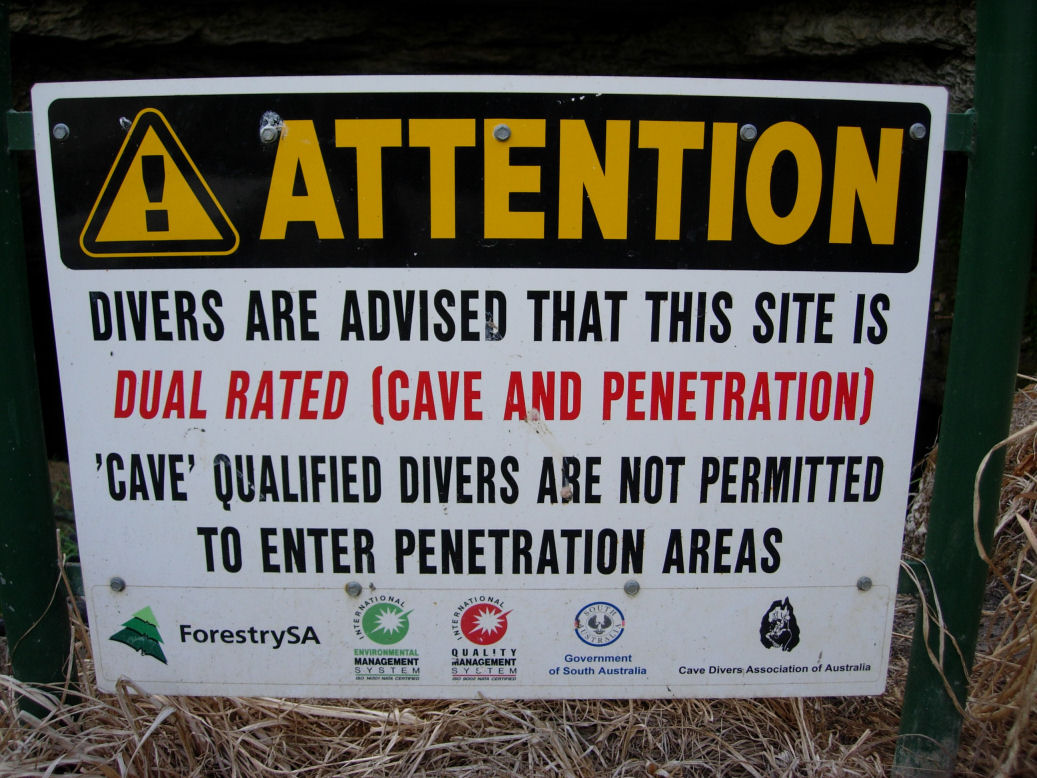
Photograph 9: Restrictions are signposted at the cave
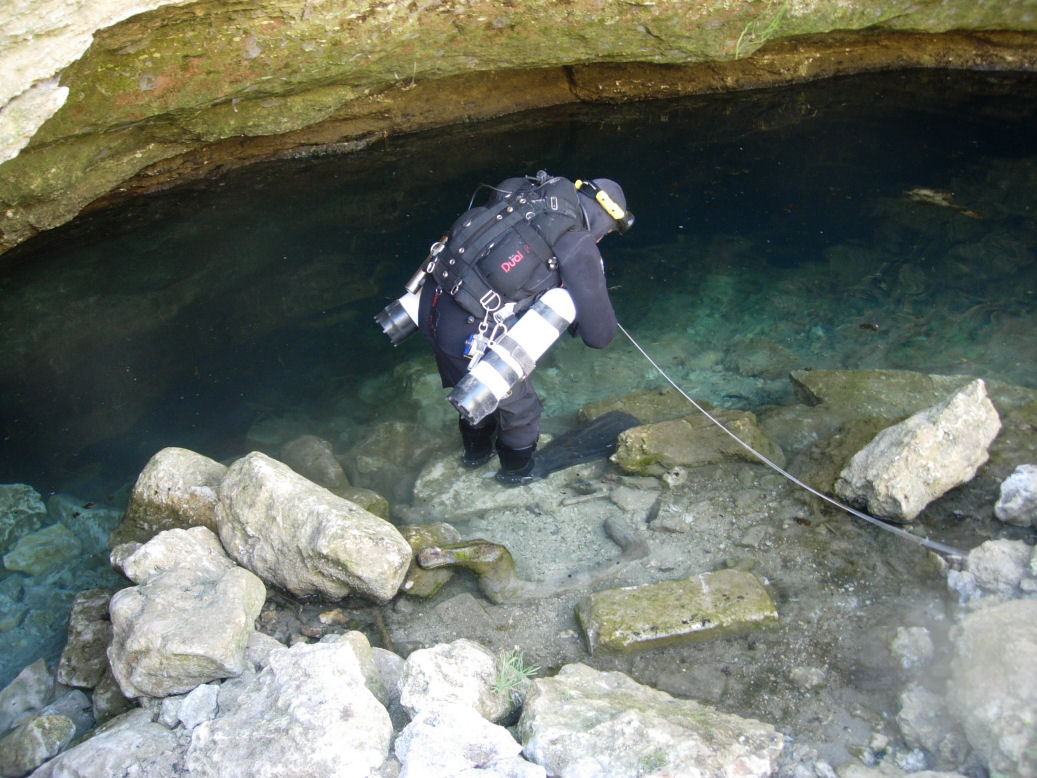
Photograph 10: Access conditions all met, a diver prepares for adventure

Photograph 11: Even inside the cave access conditions are restricted. Here is the limit that cave divers can reach; passed this point is reserved for penetration qualified divers only. There is no excuse – if you are caught sneaking a peek then you’ll be punished.
That same year the CDAA formed a policy on cave-diving in the Nullarbor and required members intending to visit the area to supply detailed trip plans at least four weeks ahead of the proposed trip, including contact details and certification levels for all divers, the intended purpose of the trip, first-aid provisions, and roping or other relevant skills within the group. The policy was a timely response to the increasing interest being shown in exploring Cocklebiddy cave.
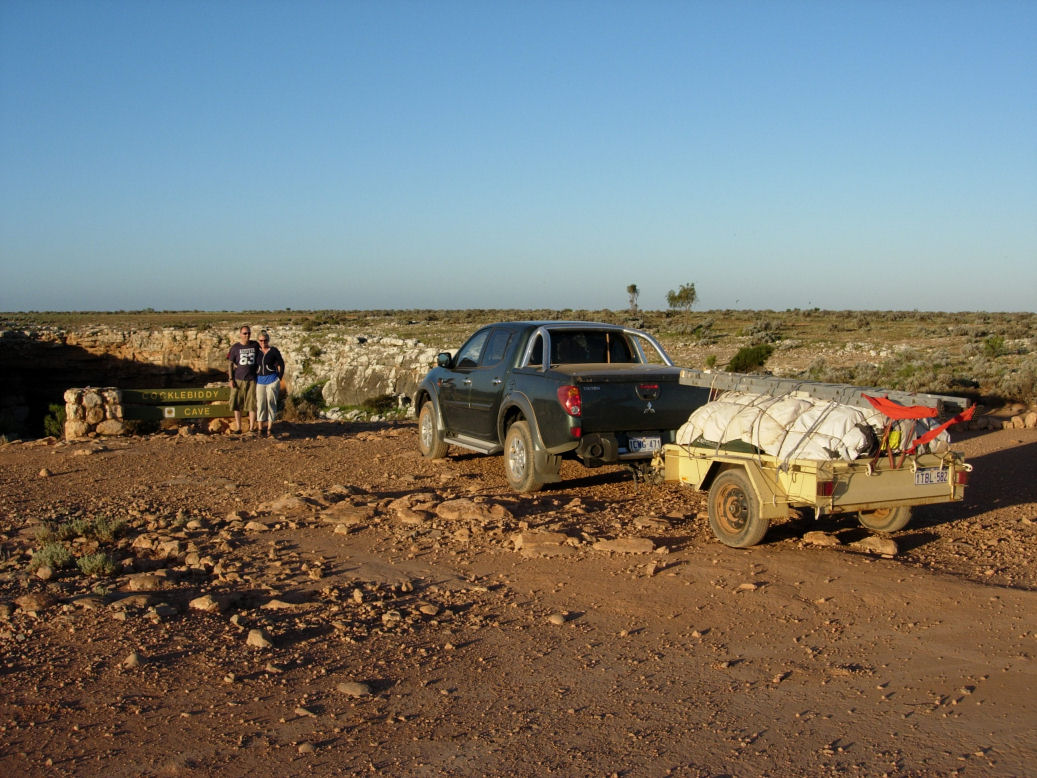
Photograph 12: The Nullarbor is not for the ill-prepared.

Photograph 13: Getting to the water requires the right equipment
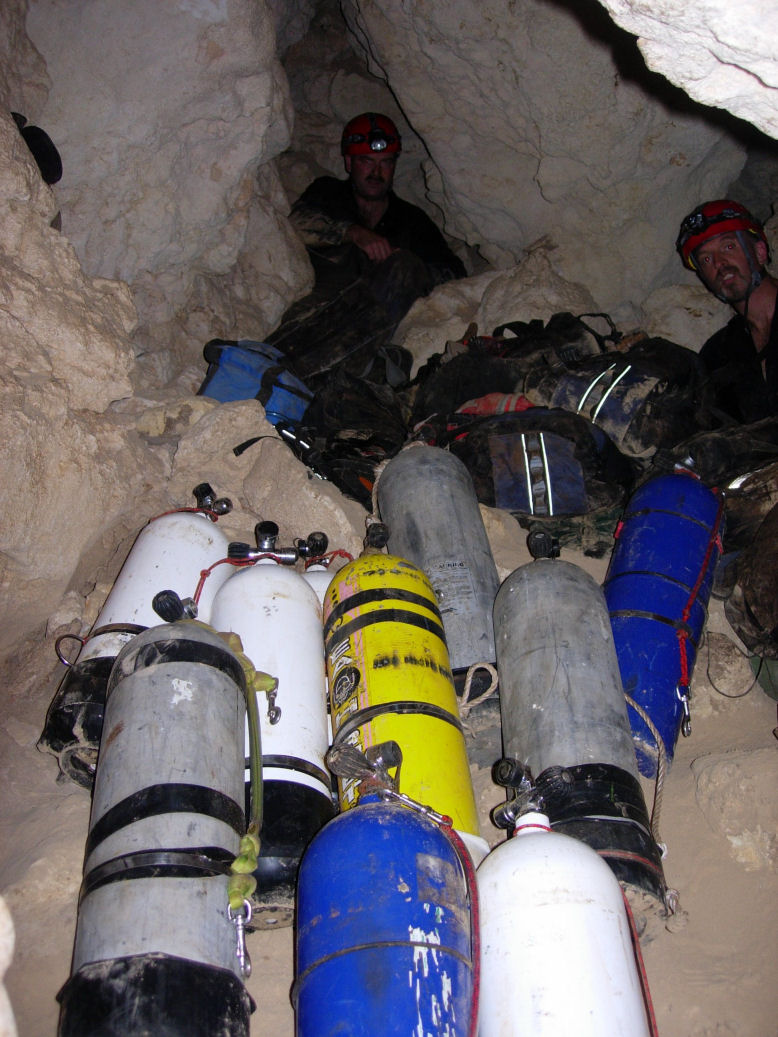
Photograph 14: Carpet is used to protect the cave in the tightest sections
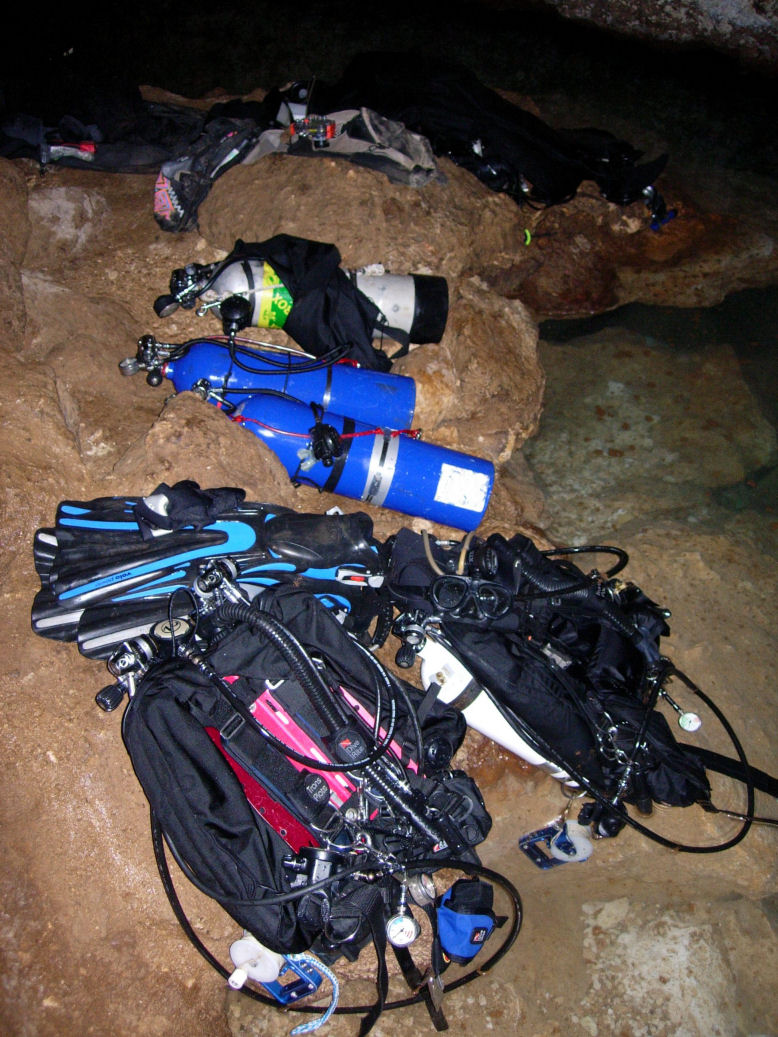
Photograph 15: Finally, the water is reached and the gear assembled
The category 1 and 2 courses were combined in 1978-79, in 1980 senior CDAA office-bearers Ian Lewis and Peter Stace published the book “Cave Diving in Australia” and by 1982 CDAA cave diving courses and examinations were on offer in four states, including now also by PADI instructors rated to category 3.5
In 1983 the CDAA had in place its first formal access agreement with a show cave, being Englebrecht’s Cave in the town of Mount Gambier itself.6 Initially a five-year agreement, the relationship has blossomed and grown over nearly 30 years and today the CDAA are again upgrading the cave diving display at Englebrechts, supplying posters and up-to-date video-footage for visitors, and the future looks bright for continued mutually beneficial collaboration between the cave managers and cave divers.
By then a largely Australian team had reached Toad Hall the year before and ABC News announced a French Team were intent on further exploration, thus setting an Australian record, perhaps even a world record. For those unaware of the now legendary Toad Hall, here is a brief description of the adventure. Firstly, divers need to travel to a spot near the Eyre Highway 440 kms east of Norseman, in Western Australia, amidst beautiful wilderness that appears limitless. Unpolluted by civilization, the night sky too is a marvel that has to be experienced to be believed and there, in this rugged, barren landscape sits the collapse doline of Cocklebiddy Cave. Clambering over boulders beneath the 10m sheer drop at the entrance, divers carry their heavy gear 100m down into the earth away from the ever-shrinking circle of light framed by the entrance. There, far below the scorching plain above, lies a crystal-clear lake a further 100m wide. The chamber is huge but the roof gradually angles down to the water and disappears beneath the surface at the far side. Divers swim across this lake, start breathing on scuba and follow the roof underwater, swimming near the roof of a ‘railway tunnel sized’ passage, with fossils and coloured bands embedded in the limestone walls. Cocklebiddy is a majestic cave and the visibility is endless, so clear at times that without the bubbles visitors would look as though they were floating in air. Early explorations set new cave diving distance records until a large air chamber was discovered at nearly 1 km distant from the cave entrance. Exploration continued, the record was set a further 1.5kms beyond this air chamber, and the Australian team later returned with the goal of exploring even further. The mission was a huge success – a second massive air chamber was discovered 2.5kms beyond the first air chamber.7 This chamber was named “Toad Hall” and a part of the sled used to carry the dive cylinders was dedicated to recording the names of visiting divers. The inscription reads “Many have wondered, but few will ever know…” and thereafter is written the reason the chamber is named Toad Hall. Last year 650 people reached the summit of Everest yet in total, less than fifty divers have their name on the visitor record in Toad Hall. It remains a pinnacle of Australian cave diving. Climbing over the rockpile in this new chamber, the divers were delighted to find yet another lake on the other side: there was more passage to explore and more diving to be done. They would train for nearly a full year before returning.
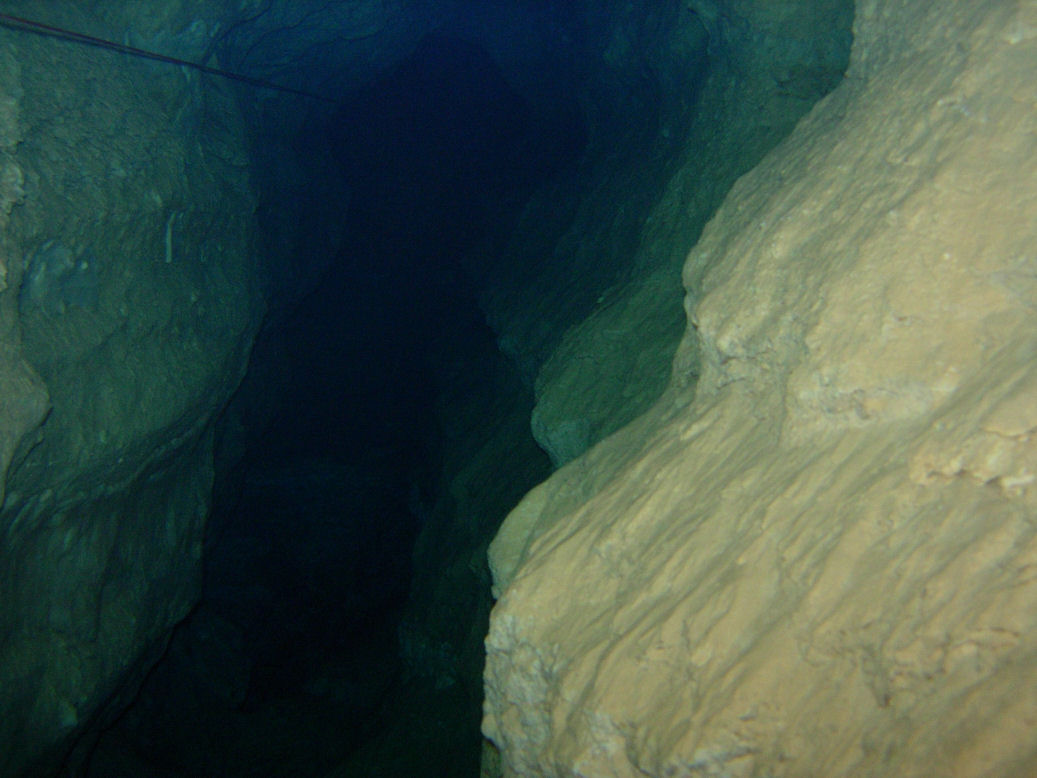
Photograph 16: The water is clear and the walls pale, conditions are excellent

Photograph 17: Here a diver visits an “air” chamber, with high CO2 levels so he keeps breathing from his scuba unit

Photograph 18: A high degree of physical stamina is required to dive the Nullarbor caves

Photograph 19: Dive teams need to be self-sufficient in every respect.
Before they could, a French team did indeed set a new record, by adding a further 1.9kms of explored passage beyond the 4.1kms record previously set by the Australian team. The French team wore triple-tank systems and it was hoped by the Australians that even further might be explored using smaller cylinders, generously pressurized. The number of air cylinders required was growing beyond the team’s available resources. To address this Hugh Morrison, one of the owners of Perth Diving Academy, advertised free tank testing for anyone who would lend him their dive tank. Then, as today, an annual test (required by Australian Standards) cost about the same as a new Top Ten record (these days, a Top Ten CD). Then, again just as it is today, divers generously supported large expeditions and so the team left Perth in a truck loaded to the roof with borrowed dive tanks. Supported by many CDAA members, Ron Allum, Peter Rogers and Hugh Morrison planned to explore further than any diver before them. Using smaller tanks worked in the Australian’s favour and Hugh explored a further 240m. It is worth noting that in the quarter of a century since, this distance has been extended, albeit rarely, and the record re-broken as recently as March this year, by another team of CDAA members.
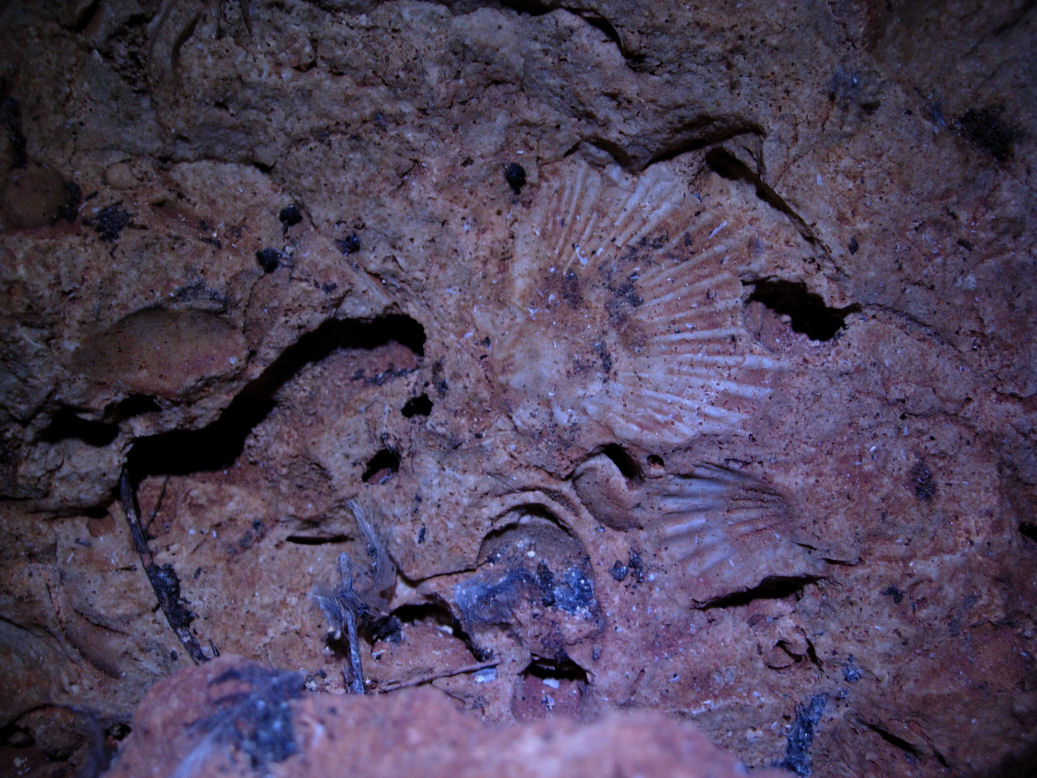
Photograph 20: Few people will ever see these fossils, far from the surface
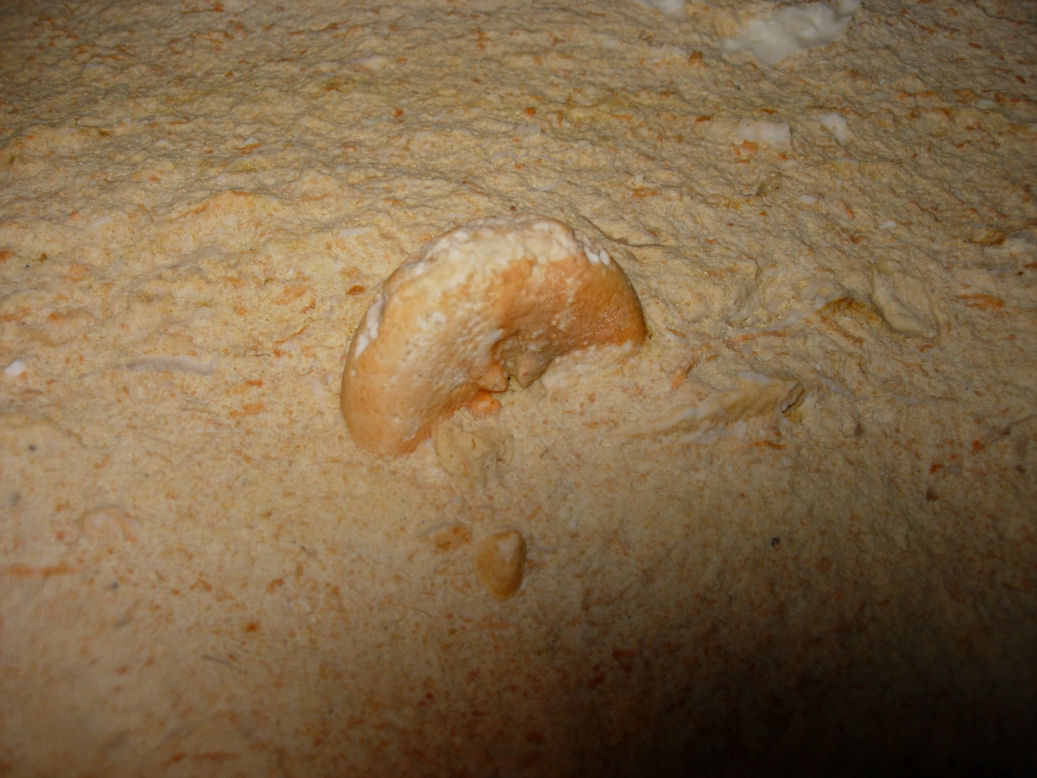
Photograph 21: A fossilised sea-urchin embedded in the wall as divers swim by
The fantastic diving in Mount Gambier then landed squarely on the world stage in 1984 with a 15-page David Doubilet feature in National Geographic.8 Having already published several books on skin diving, American Hillary Hauser’s accompanying story began “I was exhilarated beyond anything I have ever known.” (p.129). Membership plateaued after this time to around 700 members current at any time, out of more than 1,200 that had so far been tested and certified.
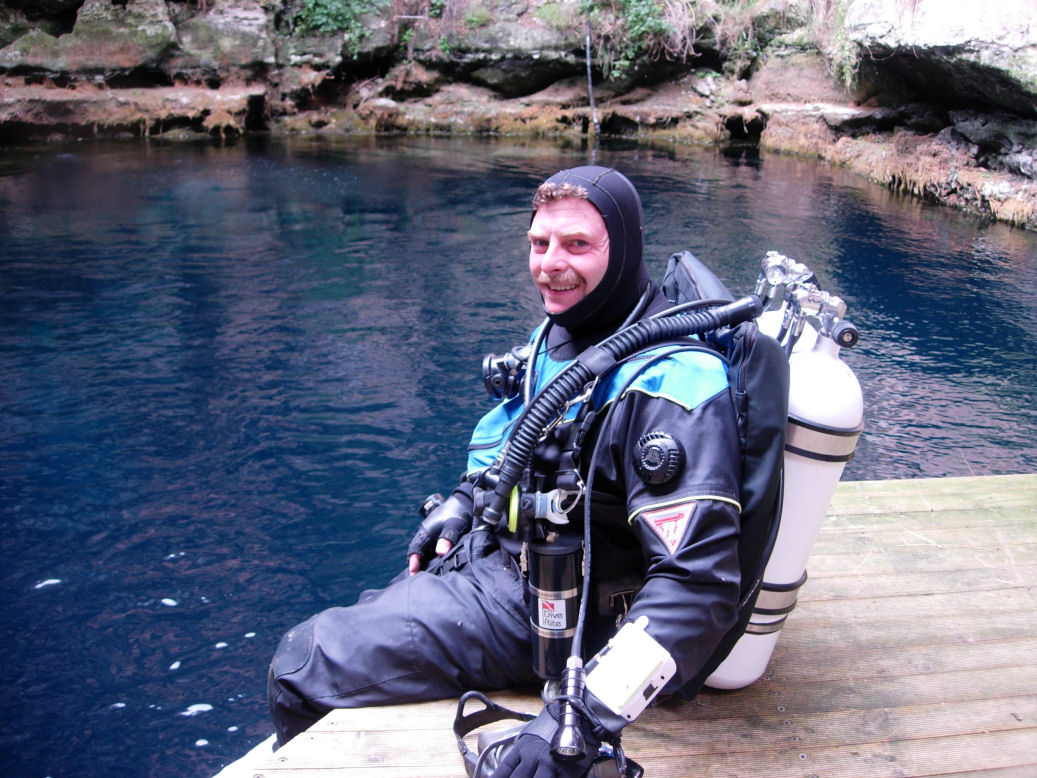
Photograph 22: Cave diving requires considerable investment in time and money
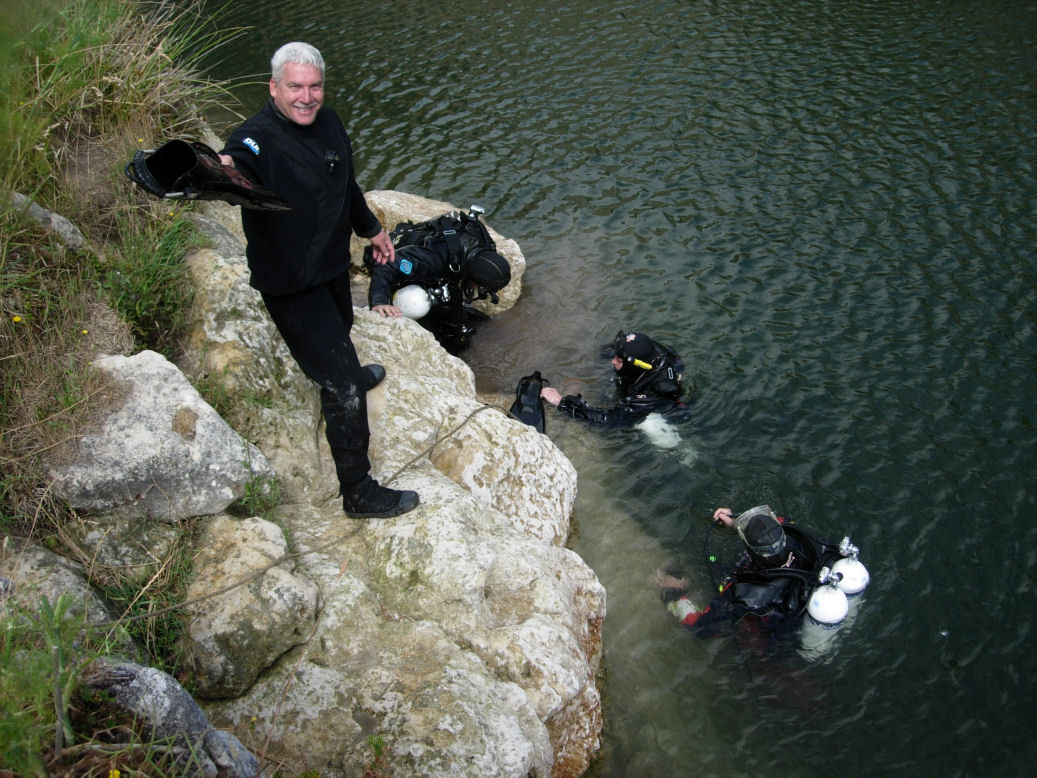
Photograph 23: Cave divers are gregarious and develop strong camaraderie

Photograph 24: Cave divers are independently equipped with two of everything, but practice supporting each other underwater as an additional contingency
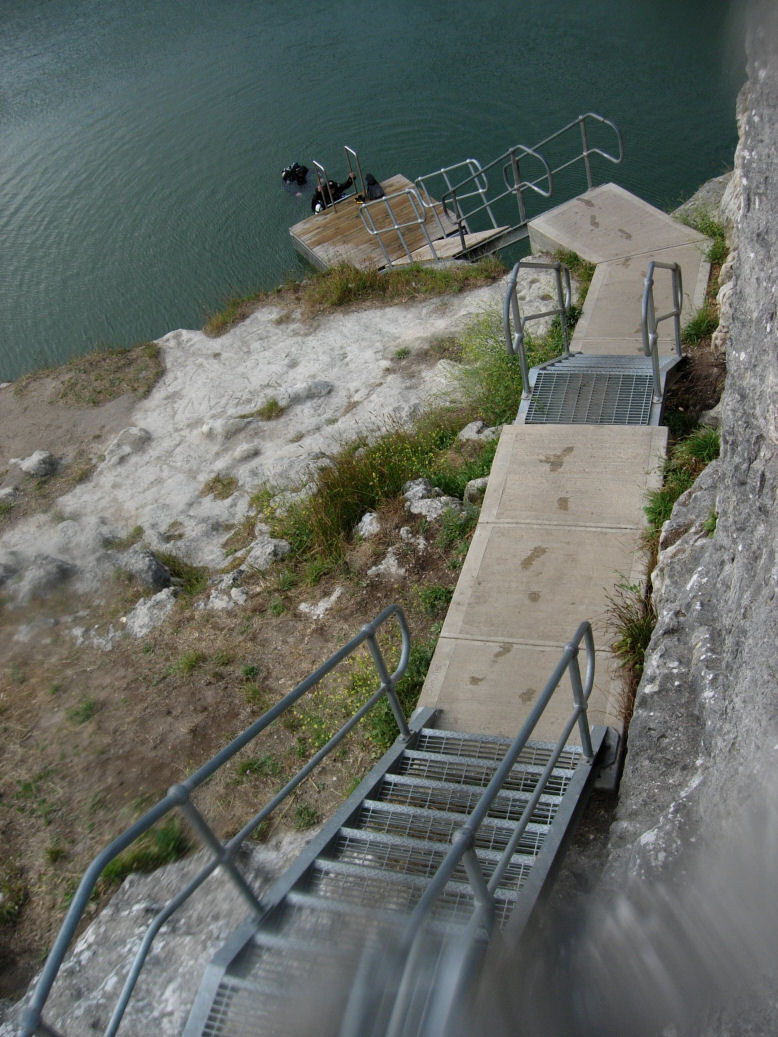
Photograph 25: The path to adventure is steep, as is the learning curve en route`
In 1989 the two state-based branches amalgamated, the unified CDAA we have today was cemented and the current organisational structure adopted. In 1990 an agreement was brokered between the CDAA and the WA Government’s Conservation and Land Management (CALM) (with none other than Dr John Watson) and an extensive training program was conducted in Weebubbie Lake, where the instructor candidates ‘taught’ previously qualified and experienced divers, and Simon Jones, (another co-owner of Perth Diving Academy), became WA’s first trained and certified “penetration” diver, still today Australia’s highest cave diver rating.
The CDAA today
Today the CDAA’s 840 members include many mature professionals such as doctors, management, academics, etc. Instructors run courses in six states and these courses are recognised worldwide by international cave diver training organisations, which is increasingly necessary because our members are travelling internationally more frequently. To afford international cave divers access to Australian caves, the CDAA administer a special visitors permit system with a raft of access conditions such as the requirement to be accompanied by a current member of the CDAA, to be sponsored by a current member, to submit copies of (and carry) recognised international certification and to abide by each site’s access conditions. In this way more than seventy international cave divers have safely visited and dived Australian caves, assisted by the CDAA. Whilst many sporting clubs and associations have struggled to stay viable during the last 35 years, especially during tough economic times, the CDAA currently retains in excess of $360,000 in an investment account, which is in addition to our day-to-day “working fund” in a cheque account. Land managers need not worry that time invested in establishing a working relationship with the CDAA may be time wasted; the CDAA has a large, stable membership base and is financially secure.
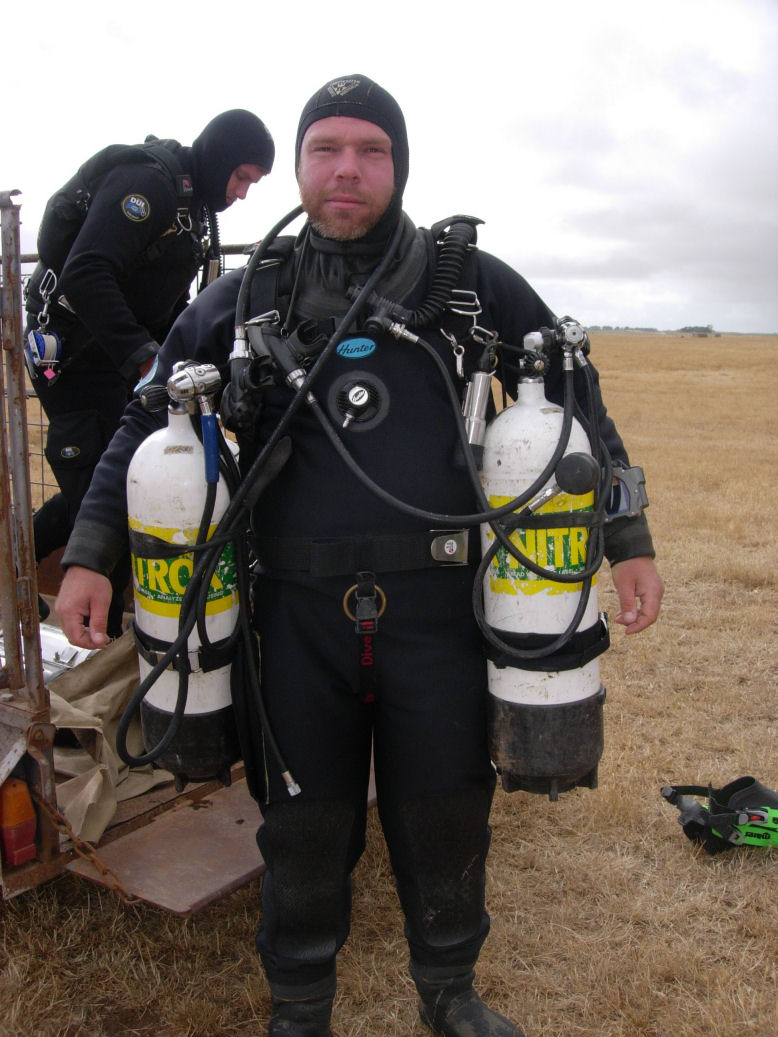
Photograph 26: The CDAA is built on a solid foundation; its membership
Keeping abreast of the rapidly changing world, our diver training courses are continually being revised, training materials upgraded and a close eye is kept on the changes being made overseas, as other agencies continually strive to improve. The CDAA publishes a full-colour quarterly journal called Guidelines, maintains an extremely active web site with sometimes dozens of e-mails reaching hundreds of divers each day as topics are discussed and news breaks. A separate, larger e-mail list is maintained for “official” news, meaning when there is a high fire-danger near a popular cave, or maintenance is being carried out, or any other event that affects access to a cave then the majority of the membership are made aware almost instantly. The CDAA supports and regularly attends related conferences, so far this year OZTeK in Sydney, the biennial ASF conference in Sale (the CDAA was a sponsor) and, of course, ACKMA in Margaret River. For our own AGMs held each year in October we have, on occasion, flown-in international speakers, last year from Germany and this year from America. In addition to hearing from some of the world’s leading explorers, often there is a scientific focus and this year we are also looking forward to a presentation by Associate Professor John Webb on the geology and hydrogeology of Mount Gambier. Since its earliest days the CDAA has enjoyed scientific collaboration with academic institutions and government. The University of South Australia, for example, recently conducted water quality sampling in four flooded caves with the help of CDAA cave divers.9 Indeed, in the latest issue there is a call for nominations for the position of CDAA Science Officer. This position, like every position in the CDAA, will be voluntary. The association is administered by volunteers, including five Directors, each with a number of Office Bearers reporting to them. Today the CDAA has three levels of diver qualifications, Deep Cavern, Cave and Penetration (soon to be Advanced Cave) and rates sites for landowners under the following headings: Cavern, Sinkhole, Cave and Penetration.
The future
Technology is changing so rapidly the CDAA is, by necessity, a dynamic organisation. Indeed, often the bringers of new methods or machinery into Australia are some of the CDAA’s leading divers. Diver Propulsion Vehicles (DPVs) are now being powered by lithium polymer batteries, rebreathers are being used to the furthest reaches of our deepest and longest flooded caves, decompression computers have replaced the old “dive tables” and divers now get minute-by-minute updates on their remaining air and decompression obligations. LED torches have pushed back the limits of how long a diver can illuminate the way (in Florida cave divers have made 27-hour dives), heated vests are allowing CDAA divers to brave the harshest of caves (the Australasian depth record was set in New Zealand by a CDAA member) and drysuits are the standard now, with “comfort” valves for males and females alike. So far this year the CDAA has called for submissions from the membership, formed sub-committees, and subsequently published policies on the use of rebreathers and DPVs in caves.
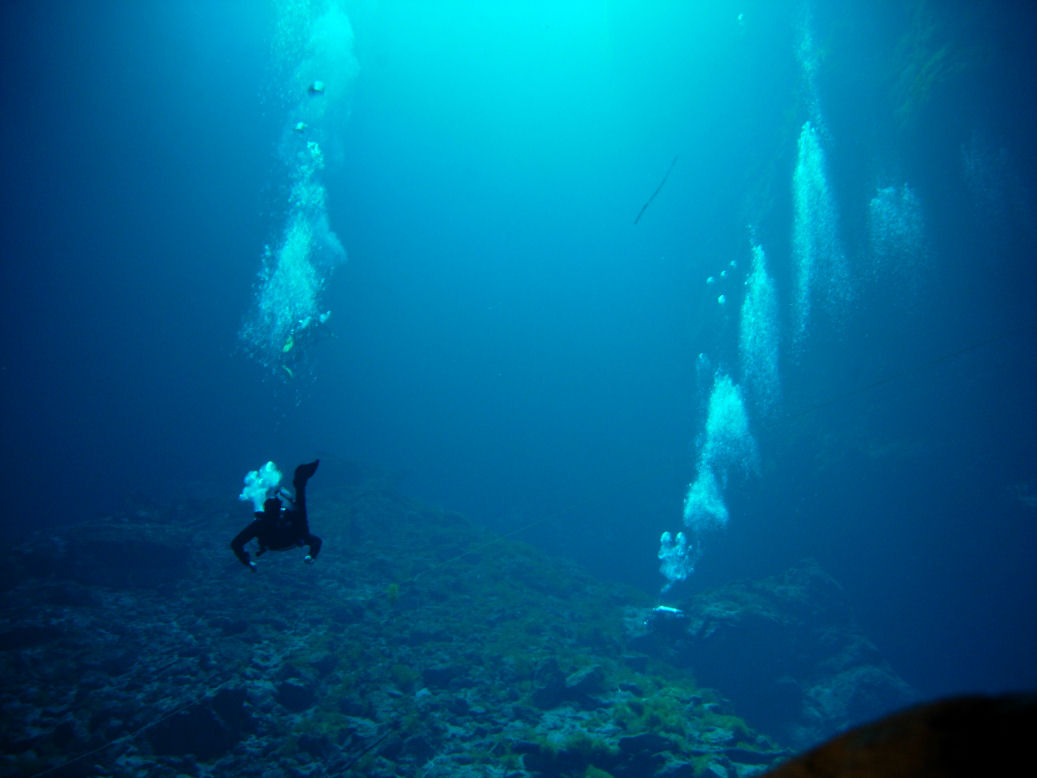
Photograph 27: The CDAA is always looking for new partnerships, to access new caves and to assist worthwhile endeavors
We are looking for more caves to dive, cementing relationships with the wider caving community, finalising and offering recognised roping courses, supporting more grass-roots activity outside of South Australia-Victoria such as state meetings and workshops in NSW, QLD and WA, we have appointed a cave diving historian and are looking to bolster our scientific endeavors. Contact us if cave divers can assist with your scientific research – many of our members are scientists themselves.
Conclusion
The Cave Divers Association of Australia is Australia’s peak cave-diving organisation. With members spread throughout Australia it is one of the largest in the world and has a safety record second to none. Our members add value to caves in many ways, for example by conducting regular clean-ups, installing and maintaining infrastructure, engaging positively with the curious public, reporting changes in water quality or water levels and, indeed, by maintaining close ties with speleo groups Australia-wide. It is only natural for cave divers to join their local caving group and the CDAA encourages this. Membership of the local speleo group is how the CDAA expects their membership to develop dry caving skills, in the same way as many speleo groups expect their own members to learn cave diving techniques through the CDAA. We encourage any office bearers of an Australian caving club reading this to circulate it within their own club with an open invitation to all cavers (who already scuba dive) to contact a CDAA instructor for information about taking that next step, to see beyond the sump. Courses are regularly advertised at www.cavedivers.com.au Likewise, the CDAA would like to hear from any caving group looking for new members and we will happily circulate membership invitations from caving clubs. Find your local state rep at:
| State/Region | Representative | Email Address |
| ACT | (Heike Apps) | actrep@cavedivers.com.au |
| NSW | (Mark Jobbins) | nswrep@cavedivers.com.au |
| NT | (Jeff Swann) | ntrep@cavedivers.com.au |
| QLD | (Tim Featonby) | qldrep@cavedivers.com.au |
| SA | (Ken Smith) | sarep@cavedivers.com.au |
| SE-SA | (Grant Pearce) | sesarep@cavedivers.com.au |
| WA | (Peter Buzzacott) | warep@cavedivers.com.au |
| VIC | (Ian Taylor) | vicrep@cavedivers.com.au |
Tasmania has some of the very best cave diving in Australia and the CDAA looks forward to seeing you all there at the 19th ACKMA conference, 2011.
References
- Cousteau J, Dumas F. The Silent World. London, UK: Hamish Hamilton Ltd; 1953; pp148.
- Byron T. History of spearfishing and scuba diving in Australia: The first 80 years, 1917-1997. Sydney, NSW.: Tom Byron Publishers Pty Ltd; 1998.
- Horne P. South Australian diving fatalities 1950 - 1985. Rev. ed. Adelaide, SA: P. Horne; 1987.
- Hiscock J. Ten years of the CDAA. The first five years, 1973-78. Guidelines. 1983; 15:12-13.
- Hiscock J. Ten years of the CDAA. The second five years, 1978-83. Guidelines. 1983; 16:16-17.
- Horne P. National Secretary's Report. Guidelines. 1983; 15:10-13.
- Rogers P. Cocklebiddy expedition 1982. Guidelines. 1982; 13:12-15.
- Hauser H. Exploring a sunken realm in Australia. National Geographic. 1984; 165(1):128-142.
- Mercurio P, Mallavarapu M, Beer M. Water quality sampling tests for the Mount. Guidelines. 2008; 106:16-17.